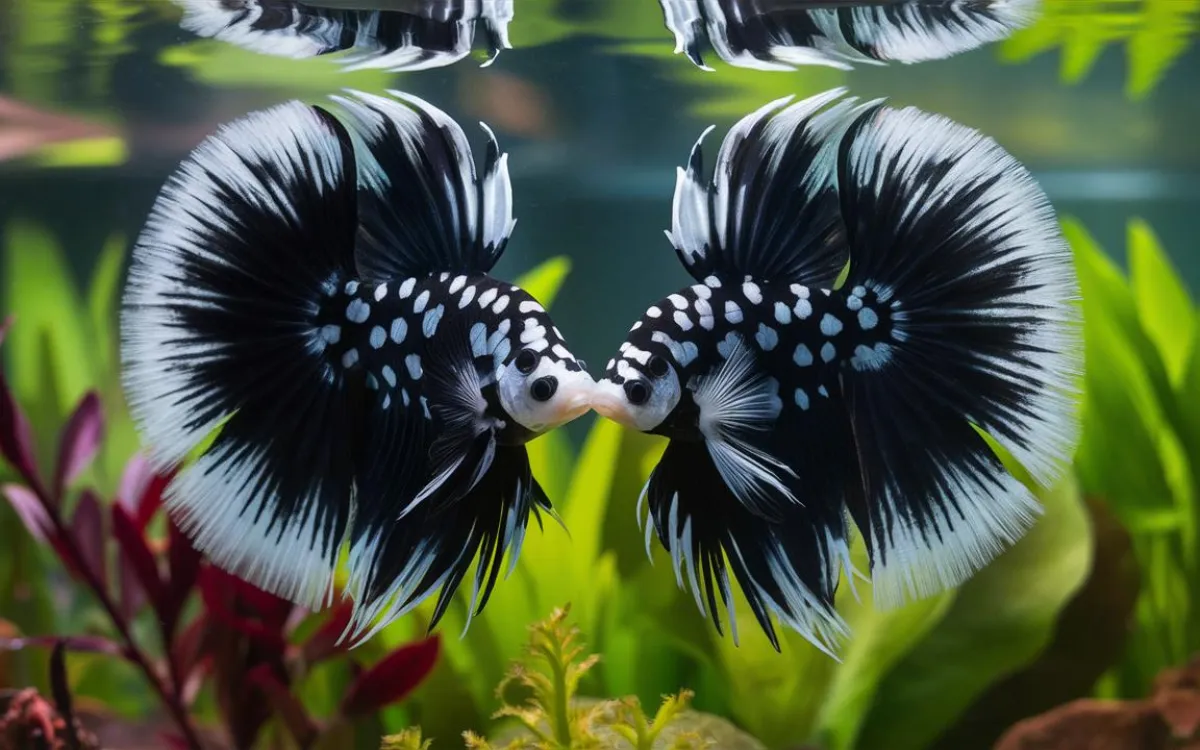Step into the captivating world of Samurai Betta fish, where flowing fins and vibrant colors collide in a mesmerizing aquatic dance. These stunning creatures, named for their resemblance to the elaborately armored warriors of ancient Japan, are a testament to the artistry of selective breeding.
Let’s find out with Betta Fish Information now!
Unveiling the Splendor: Understanding the Samurai Betta
Samurai Bettas, a variant of the popular Siamese Fighting Fish (Betta splendens), are prized for their long, flowing fins that evoke images of billowing samurai battle flags. Their striking appearance is a result of careful selective breeding, emphasizing finnage development and vibrant color combinations.
Elongated Fins: The most prominent feature of the Samurai Betta is their exceptionally long fins, particularly the caudal (tail) fin. These fins can grow to be several times the length of their body, creating a mesmerizing display of flowing elegance.
Variety of Tail Types: Samurai Bettas exhibit a diverse range of tail types, including veil tail, halfmoon, crowntail, and plakat. Each tail type possesses its own unique charm and adds to the allure of these captivating fish.
Vibrant Colors and Patterns: Samurai Bettas come in a kaleidoscope of colors, from fiery reds and oranges to deep blues and purples. Their scales often shimmer with iridescent hues, adding to their visual appeal.
Creating a Royal Court: Setting Up the Perfect Samurai Betta Habitat

Providing a suitable environment is paramount to the health and well-being of your Samurai Betta. These fish, while relatively hardy, thrive in specific water conditions and benefit from a well-structured aquarium that mimics their natural habitat.
Tank Size and Setup: A Palace Fit for Royalty
Minimum Tank Size: A 5-gallon tank is the absolute minimum for a single Samurai Betta. However, larger tanks (10 gallons or more) are highly recommended, especially if you plan on keeping a community tank.
Filtration and Heating: A gentle filter with adjustable flow rates is essential for maintaining water quality without creating strong currents that can damage the delicate fins of Samurai Bettas. A reliable heater is crucial for maintaining a stable water temperature between 78-82°F (25-28°C).
Aquascaping: Create a visually appealing and enriching environment by incorporating live plants, caves, rocks, and driftwood. These elements provide hiding spots, reduce stress, and mimic their natural habitat.
Water Parameters: Maintaining a Pristine Aquatic Realm
pH Level: Samurai Bettas prefer slightly acidic water with a pH level between 6.5-7.5.
Water Hardness: Aim for a water hardness between 5-10 dGH (general hardness).
Ammonia, Nitrite, and Nitrate: These harmful compounds should always be kept at 0 ppm (parts per million). Regular water changes (25% weekly) are essential for removing these toxins.
A Royal Feast: Feeding Your Samurai Betta
Providing a balanced and nutritious diet is essential for maintaining the vibrant colors, flowing fins, and overall health of your Samurai Betta.
Staple Diet: High-Quality Betta Pellets
Protein Content: Choose betta pellets with a high protein content (40% or more) derived from fish meal or other high-quality sources.
Vitamin and Mineral Enrichment: Look for pellets fortified with essential vitamins and minerals to support overall health and immune function.
Treats and Supplements: Adding Variety and Enrichment
Live and Frozen Foods: Supplement pellet meals with live or frozen foods like brine shrimp, daphnia, bloodworms, and mosquito larvae. These treats provide enrichment and mimic their natural diet.
Freeze-Dried Foods: Freeze-dried foods, while not as nutritionally complete as live or frozen options, can be offered as occasional treats.
The Art of Samurai Betta Breeding: A Delicate Dance
Breeding Samurai Bettas can be a rewarding experience, allowing you to witness the fascinating lifecycle of these captivating creatures. However, it’s crucial to approach breeding responsibly, ensuring the well-being of both the parent fish and their offspring.
Selecting Breeding Pairs: The Foundation of Success
Healthy and Mature Fish: Choose healthy, mature fish that are at least 6 months old.
Compatible Temperaments: Observe the temperament of potential breeding pairs. Avoid pairing aggressive fish, as this can lead to injuries or stress during the breeding process.
Desirable Traits: Select fish with desirable traits that you wish to pass on to their offspring, such as vibrant colors, long fins, and specific tail types.
Conditioning the Breeding Pair: Preparing for Spawning
Separate Tanks: Condition the male and female in separate tanks for 7-10 days prior to breeding.
High-Protein Diet: Feed the breeding pair a high-protein diet consisting of live or frozen foods to encourage spawning behavior.
Water Changes: Perform frequent water changes (25% every other day) to maintain pristine water quality.
The Breeding Tank: Creating the Ideal Environment
Tank Size: A 10-gallon tank is ideal for breeding Samurai Bettas.
Water Level: Keep the water level lower than usual (around 6 inches) to facilitate bubble nest building and fry survival.
Spawning Site: Provide a spawning site, such as a floating betta log or a clump of floating plants.
Gentle Filtration: Use a sponge filter or adjust the flow rate of your existing filter to create a gentle current.
Conclusion
Caring for Samurai Bettas is a rewarding experience that allows you to witness the captivating beauty and intriguing behaviors of these remarkable creatures. By understanding their needs, providing a suitable environment, and approaching breeding responsibly, you can ensure your Samurai Bettas thrive and bring joy for years to come. Remember, responsible betta keeping involves continuous learning and a commitment to providing the best possible care for these captivating aquatic companions.

Related Posts
The Elegance Of Female Betta Fish: A Comprehensive Guide
Understanding Super Red Betta Fish: A-to-Z Care Guide
What Is Koi Betta Fish? Common Types Of Koi Betta Fish